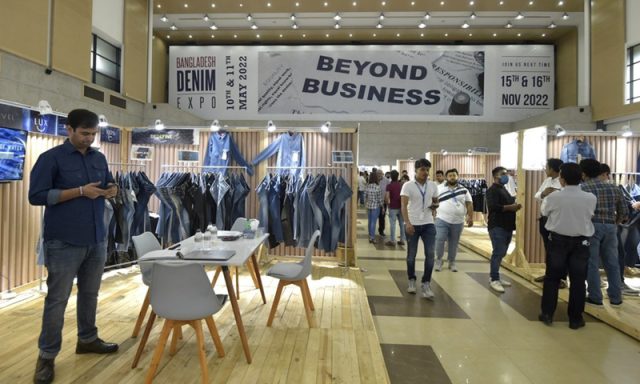According to multinational apparel retailers and brands, Bangladesh will continue to be the preferred sourcing destination for readymade garment (RMG) goods in the future because the country has significantly improved production facilities and regulatory compliance in recent years. In addition, according to foreign buyers, Bangladesh’s workplace safety and regulatory compliance have greatly improved after the Rana Plaza building collapsed in April 2013. The editorial is about Futuristic View of RMG Sector in Bangladesh.
As a result, shops and brands are bringing in more work orders as the COVID-19 situation improves, and the local garment sector has demonstrated its strength. “Bangladesh is our most significant sourcing destination,” Ziaur Rahman, regional head for Bangladesh, Pakistan, and Ethiopia for Swedish retailer H&M, said at the 12th Bangladesh Denim Expo in Dhaka. “Bangladesh is one of our most significant markets. So we’re going to stay here.” Currently, his company is sourcing clothes items from 300 garment companies.
“In terms of workplace safety, compliance, and product variety. It has the potential to export $100 billion worth of garments in the next ten years, “Rahman stated. Bangladesh was in a very different state even five years ago. But now, he continued, the country has much improved, and he plans to raise the volume of things sourced from here by 11% in the next five years.
He added that Bangladesh has flexibility, maturity, innovation, and more green garment factories and goods. Similarly, Shafiur Rahman, regional operations manager of Dutch designer apparel business G-Star, claimed his company imports $70 million worth of garments from Bangladesh each year, with knitwear accounting for 75% of the total.
But, he noted, his company has recently expanded into buying non-knitwear items such as denim. In the following three years, his company plans to raise the number of things sourced from here by 30%, bringing the total worth to $90 million. But, he stated, “We cannot even consider sourcing garment things without Bangladesh.”
Tonello, an Italian garment machinery producer and supplier, has been supplying machinery to Bangladesh for the past 28 years, according to Alice Tonello. Her company has provided 1,500 textile and garment manufacturing and washing machines to Bangladeshi garment manufacturers.
“Bangladesh is the most important market for us. The demand for our machinery in Bangladesh has grown a lot every year. So, the garment sector will continue to grow in the future,” said Tonello, representing the second generation of the family business. Yilmaz Demir, regional sales manager for Asia of Turkish company Bossa, said his company sells about one million yards of denim fabrics worth €5 million in Bangladesh a year.
“I have been supplying denim fabrics over the last 16 years. I have been looking after business in Bangladesh for many years. Bangladesh is doing good as the factories improved production facilities,” he said. “But the prices of raw materials have increased a lot after the Covid pandemic. So Bangladesh is the best,” he said. But changes in the Generalized System of Preferences for Bangladesh may be an issue for the country in the future.
Rashid Iqbal, executive director of Pakistan-based denim fabrics manufacturer Naveena Export, said his company has much confidence in Bangladesh because of the country’s improvements in compliance with regulations. His company ships 5 lakh meters of denim fabrics worth $1.7 million to Bangladesh in a month. He has an office in Dhaka and has supplied denim fabrics to Bangladeshi partners over the last 15 years.
“Bangladesh is a solid market for us,” said Rashid. Dolly Thay, Managing Director of buying house Cloths “R” Us, said work orders were shifting from China, Vietnam, Sri Lanka, Myanmar, and Sri Lanka as Bangladesh has grown a lot concerning its capacity over the last few decades. However, the profit margin from the export of garment items is still shallow.
“Bangladesh should be proud of what has been achieved. Bangladesh has made huge strides towards a more sustainable garment sector,” said Anne Van Leeuwen, ambassador of the Netherlands to Bangladesh. “I often challenge people to give me another example of a sector that has turned around the image and its degree of compliance in such a short amount of time. But, unfortunately, I never get a serious reply,” he said.
“But let’s also not be complacent. Challenges remain. Garment workers in Bangladesh today are affected by how sourcing takes place in Bangladesh,” said Leeuwen. “And given the scale of the industry in Bangladesh, there is plenty of work to be done in decreasing the sector’s environmental impact,” he added.
Mostafiz Uddin, the founder of Bangladesh Denim Expo, said some 85 companies came to showcase their products, of which 30 were local and the rest foreign ones from 39 countries. “The response from the participants is beyond my imagination,” he said, adding that after a gap of two years for the COVID-19 pandemic, it was the most successful denim expo yet in the country. Unfortunately, the event will come to an end today, he said.
To explore more Editorials, Please Click Here!



















